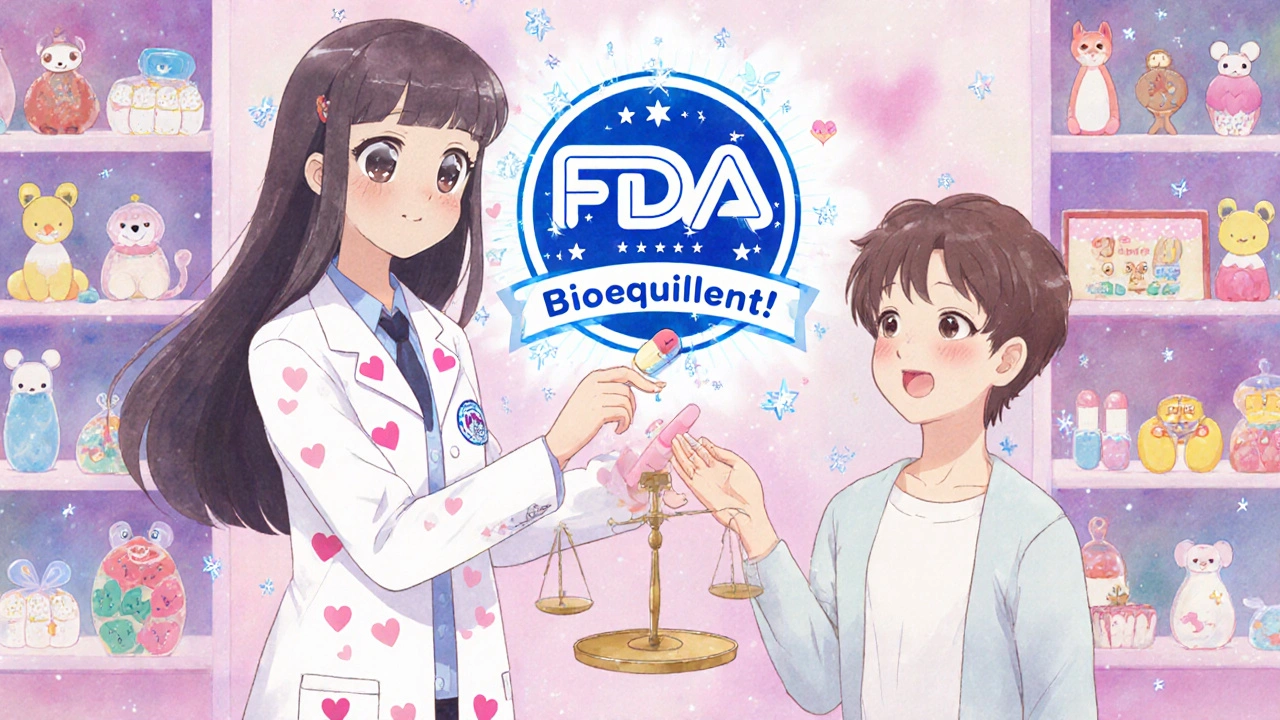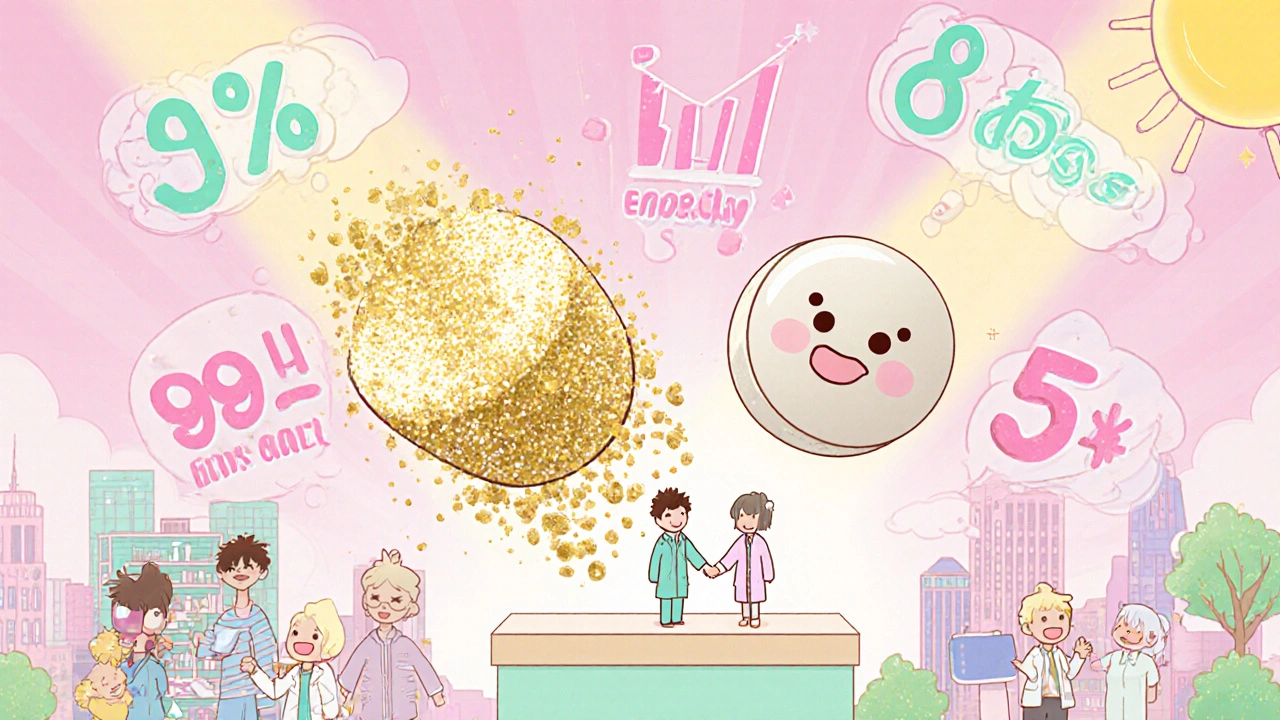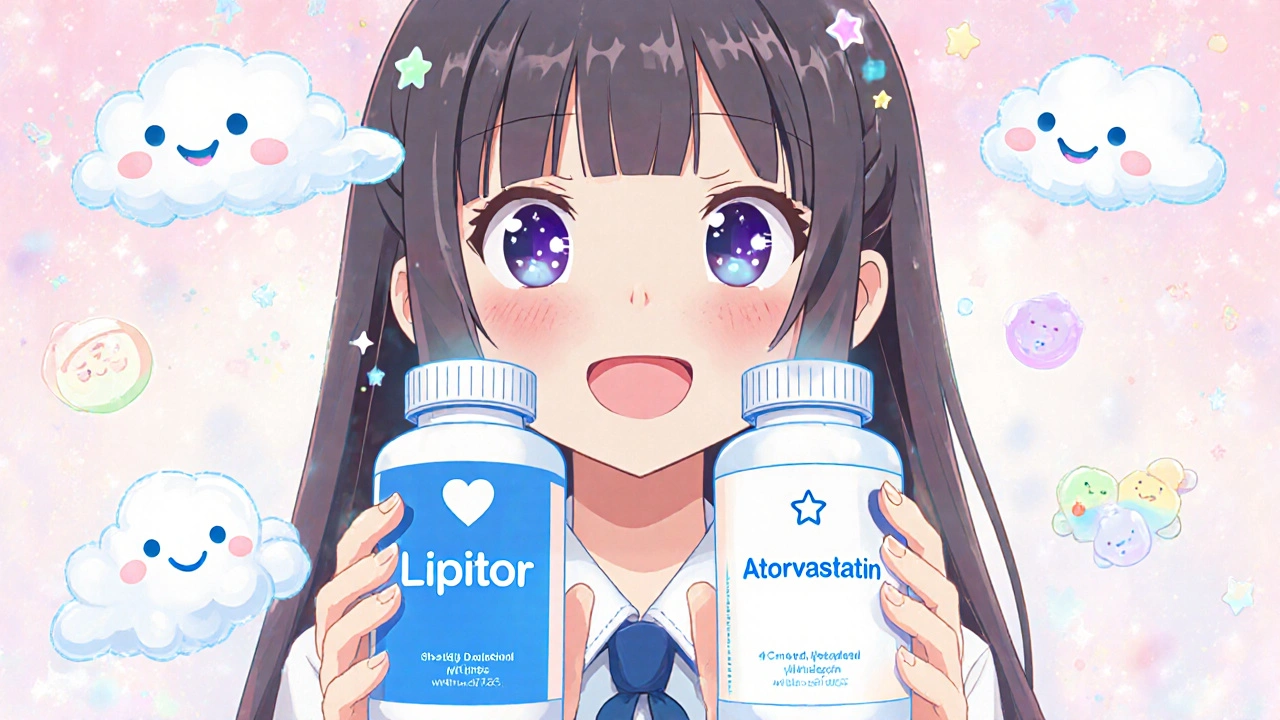When you pick up a prescription and see a different name on the bottle than what your doctor wrote, it’s natural to wonder: are generic drugs copies? Are they weaker? Less safe? Just cheap imitations? The answer isn’t as simple as yes or no - but the science is clear.
What Exactly Is a Generic Drug?
A generic drug isn’t a copy in the way a bootleg DVD is a copy. It’s a scientifically approved equivalent. The U.S. Food and Drug Administration (FDA) requires that generic drugs contain the same active ingredient, in the same strength, same dosage form (tablet, capsule, injection), and same route of administration (oral, topical, etc.) as the brand-name version. That means if your doctor prescribes lisinopril for high blood pressure, the generic version has the exact same molecule doing the same job in your body. The FDA doesn’t just accept claims - they demand proof. Before a generic drug hits the shelf, manufacturers must show bioequivalence. That means the generic must deliver the same amount of active ingredient into your bloodstream at the same rate as the brand-name drug. The standard? The 90% confidence interval for both the area under the curve (AUC) and maximum concentration (Cmax) must fall between 80% and 125% of the brand-name drug. That’s not a guess - it’s a strict, measurable benchmark.Why Do Generic Drugs Look Different?
If the active ingredient is identical, why do generics look different? Color, shape, size, flavor, even the coating - those are all inactive ingredients. These are called excipients: fillers, binders, dyes, preservatives. They help the pill hold together, make it easier to swallow, or give it a distinct appearance. But they don’t affect how the drug works. U.S. trademark laws require generics to look different from brand-name drugs. That’s why your brand-name Lipitor is a blue oval pill, but the generic atorvastatin might be white and round. It’s not a trick - it’s the law. And even though the outside changes, the inside? Identical.How Much Cheaper Are Generic Drugs?
The biggest difference between brand-name and generic drugs? Price. On average, generic drugs cost 85% less. According to the Congressional Budget Office (2021), a brand-name drug might run $60 per prescription. The generic? Around $9. GoodRx data from 2023 shows the average generic costs just $4.27 per fill, compared to $61.85 for the brand. That’s not a small savings. For people on chronic medications - statins, blood pressure pills, thyroid meds - switching to generic can mean saving hundreds, even over $500 a year. Medicare Part D beneficiaries report average annual savings of $500 or more just by using generics. And it’s not just individuals. The entire U.S. healthcare system saves billions. Generic drugs make up 90% of all prescriptions filled but only 23% of total drug spending.Are Generic Drugs as Effective?
Yes - for the vast majority of drugs. The FDA states plainly: “Generic drugs work the same as brand-name drugs in the same way and provide the same benefit(s).” Studies back this up. A 2022 review in Health found little to no difference in outcomes between generics and brand-name drugs across dozens of conditions. Harvard’s Dr. Choudhry noted that cost-related non-adherence affects 25% of patients on brand-name drugs, but only 8% on generics. When people can afford their meds, they take them - and outcomes improve. A 2023 analysis of 1.2 million reviews on Drugs.com showed generic drugs averaged a 7.2/10 effectiveness rating, compared to 7.5/10 for brand-name. That’s a tiny gap - and one that’s likely due to placebo effect or individual variation, not inferior quality.
When Might Generics Not Be the Same?
There’s one critical exception: narrow therapeutic index (NTI) drugs. These are medications where even a tiny change in blood levels can cause serious problems - either the drug stops working, or it becomes toxic. Examples include:- Warfarin (blood thinner)
- Levothyroxine (thyroid hormone)
- Phenytoin, carbamazepine (antiseizure meds)
What About Quality and Safety?
Some people assume generics are made in lower-quality factories. That’s not true. The same factories often make both brand-name and generic versions. In fact, over 50% of generic drugs sold in the U.S. are made by the same companies that make the brand-name versions. The FDA inspects all manufacturing facilities - brand and generic - with the same standards. Between 2018 and 2022, the FDA reviewed over 1,800 reports of possible issues with generic drugs. Only 5.5 cases per year were confirmed as actual bioequivalence failures. That’s 0.3%. And here’s something surprising: The FDA’s own testing shows generics contain, on average, 99.2% of the labeled active ingredient. That’s more precise than the brand-name drugs themselves.Why Do Pharmacists Substitute Generics?
In 49 states, pharmacists can automatically switch a brand-name prescription to a generic unless the doctor says “do not substitute.” That’s because the law assumes they’re interchangeable - and it saves money. In states with mandatory substitution laws, prescription drug spending dropped by 12.7%, with no drop in health outcomes, according to Harvard’s Aaron Kesselheim. Patients can still request the brand name - and in 28 states, insurers must cover it at the generic price if the doctor confirms it’s medically appropriate. But most don’t ask. A Kaiser Family Foundation survey found 78% of insured adults get generics as their first option - and 89% are satisfied.
Why Do People Still Doubt Generics?
Misinformation spreads fast. A Brown University Health survey found 65% of patients unnecessarily request brand-name drugs. And 43% believe generics contain only 20-80% of the active ingredient. That’s not just wrong - it’s dangerously wrong. The FDA tests show generics meet exacting standards. Part of the problem? Marketing. Brand-name companies spend billions on ads that make their drugs seem superior. Generics don’t advertise. So people assume the cheaper option is the lesser one. But in medicine, price doesn’t always reflect quality - especially when the science says otherwise.What’s Changing Now?
The generic drug market is evolving. Biosimilars - complex generics for biologic drugs like Humira or Enbrel - are growing fast. As of 2023, less than 5% of biologics have biosimilar alternatives, but that’s changing. The FDA’s 2023 plan aims to cut approval times for complex generics from 38 months to 10 months by 2027. New laws are pushing more substitution too. The 2022 Consolidated Appropriations Act requires Medicare Part D to automatically use generics unless medically inappropriate - a move projected to save $156 billion over ten years. And with blockbuster drugs like Eliquis and Entyvio going generic in 2023, billions more in savings are on the way.What Should You Do?
If you’re prescribed a medication, ask your pharmacist: “Is there a generic?” If there is, and it’s not an NTI drug, take it. You’ll save money with no loss in effectiveness. If you’re on warfarin, levothyroxine, or an antiseizure drug, talk to your doctor. You might do better sticking with one version - but not because generics are unsafe. It’s about consistency. And if you’ve had a bad experience after switching? Tell your provider. But don’t assume it’s the generic’s fault. Often, it’s something else - diet, other meds, stress. Keep a log. Track symptoms. Don’t let myths keep you from affordable care.Final Takeaway
Generic drugs aren’t copies. They’re legally required, scientifically proven equivalents. They work the same. They’re just cheaper. For 90% of prescriptions, switching to generic is a smart, safe, and simple way to save money without sacrificing health. The science doesn’t lie. The data doesn’t lie. And the billions in savings across the U.S. healthcare system? That doesn’t lie either.Are generic drugs less effective than brand-name drugs?
No. Generic drugs must meet the same FDA standards for safety, strength, quality, and performance as brand-name drugs. They contain the same active ingredient and deliver it to your bloodstream at the same rate and amount. Studies and real-world data show they work just as well for the vast majority of medications.
Why are generic drugs so much cheaper?
Generic manufacturers don’t have to repeat expensive clinical trials because they prove bioequivalence to the original drug instead. They also don’t spend billions on advertising. This cuts their costs dramatically, and those savings are passed on to patients. On average, generics cost 85% less than brand-name versions.
Do generic drugs have the same side effects?
The side effects from the active ingredient are the same. But because generics can use different inactive ingredients (like dyes or fillers), some people may notice minor differences - like a stomach upset or rash - due to an allergy or sensitivity to an excipient. These are rare and usually not serious. If you notice a change after switching, talk to your doctor or pharmacist.
Can I trust generics made in other countries?
Yes. The FDA inspects all manufacturing facilities - whether in the U.S., India, China, or elsewhere - with the same strict standards. Over half of all generic drugs sold in the U.S. are made overseas, and they must meet the same quality controls as U.S.-made drugs. The FDA has the authority to block imports if standards aren’t met.
Are there any drugs where I should avoid generics?
For most drugs, no. But for narrow therapeutic index (NTI) drugs like warfarin, levothyroxine, and certain seizure medications, even small differences in absorption can matter. Your doctor may recommend staying on one version - brand or generic - to keep your levels stable. Always follow your provider’s advice for these medications.
Why do generics look different from brand-name drugs?
U.S. trademark laws require generics to look different to avoid confusion. The shape, color, or size may change - but the active ingredient, strength, and effect are identical. These visual differences are only in the inactive ingredients, which don’t affect how the drug works.
Can pharmacists switch my prescription to a generic without asking me?
In 49 states, yes - unless your doctor writes “dispense as written” or “no substitution.” Pharmacists are trained to know which substitutions are safe and legal. You can always ask for the brand name, and in 28 states, insurers must cover it at the generic price if your doctor says it’s necessary.
How do I know if my generic drug is FDA-approved?
All legally sold generic drugs in the U.S. must be FDA-approved. You can check the FDA’s Orange Book online to verify if a generic version of your drug is approved. But you don’t need to check - if your pharmacy dispenses it, it’s already approved. Look for the manufacturer’s name on the label - it’s not a red flag, it’s proof it’s legitimate.

 Nov, 14 2025
Nov, 14 2025

Latrisha M.
November 14, 2025 AT 17:41Generics saved me over $600 last year on my blood pressure med. I was skeptical at first but my labs haven’t changed a bit. No side effects, no issues. Just cheaper and just as effective.
Jamie Watts
November 15, 2025 AT 21:11lol people still think generics are fake? bro the FDA doesn’t play around if you think your pill is weak go check the orange book its all public info and the bioequivalence range is 80-125 not 50-50 so stop being a scaredy cat
Dan Angles
November 16, 2025 AT 17:07The scientific consensus on generic pharmaceutical equivalence is unequivocal. Regulatory frameworks established by the FDA ensure that bioequivalence criteria are met through rigorous pharmacokinetic studies. The assertion that generics are inferior is not supported by empirical data and reflects a misunderstanding of regulatory science.
David Rooksby
November 18, 2025 AT 08:31you ever wonder why the big pharma companies push generics so hard? they own the factories in india and china that make them. same pill same factory just a different label. the real drug is still made by the same people who made the brand name. they just stopped paying for ads and now they’re making 10x profit on the same batch. and you think you’re saving money? nah you’re just feeding the machine
Melanie Taylor
November 19, 2025 AT 00:37I switched to generic levothyroxine last year and had a weird panic attack 😬. Went back to brand-calm as a cucumber. My doctor said it’s not the drug, it’s the fillers. So now I stick with Synthroid. Not because it’s better, just because my body knows it. 🤷♀️
Teresa Smith
November 20, 2025 AT 20:48It is not merely a matter of cost savings-it is a moral imperative. Access to essential medication should not be contingent upon socioeconomic status. The widespread adoption of generics reduces financial toxicity and promotes health equity. To resist them is to perpetuate systemic harm under the guise of misplaced trust in branding.
ZAK SCHADER
November 22, 2025 AT 06:45generic drugs are made in china and they put rat poison in em to save money. my cousin got sick after switching and now he’s on dialysis. FDA dont inspect nothin. they get paid off by big pharma. you think they care about you? nah they care about profit
Danish dan iwan Adventure
November 24, 2025 AT 04:48Bioequivalence is a statistical construct, not a biological guarantee. Cmax and AUC thresholds are arbitrary. Individual pharmacogenomic variance is ignored. NTI drugs are the tip of the iceberg. The system is designed for population-level efficacy, not individual precision.
Ankit Right-hand for this but 2 qty HK 21
November 26, 2025 AT 03:17you americans are so gullible. you think your FDA is some holy guardian? the same companies that make brand drugs own 70% of generics. they just repackaged the same shit. you think your $4 pill is safer? it’s the same factory, same workers, same batch. you’re just paying less because you’re too dumb to ask why.
Oyejobi Olufemi
November 27, 2025 AT 03:36Let me tell you something… the truth is buried under layers of corporate propaganda, regulatory capture, and mass psychological conditioning… the FDA doesn’t test for long-term effects… they only test for blood levels… what about the metabolites? the impurities? the epigenetic consequences? we’re guinea pigs… and you just swallow it… literally…
Daniel Stewart
November 27, 2025 AT 21:18There’s something almost poetic about how we’ve turned medicine into a commodity. We optimize for cost efficiency, yet we cling to the illusion that price reflects value. The pill doesn’t care if it’s branded or generic-it only knows chemistry. We’re the ones who assign meaning to color and shape.
John Mwalwala
November 28, 2025 AT 11:20Did you know that 60% of generic manufacturers use the same inactive ingredients as the brand? But here’s the thing-some of those excipients are patented. So technically, the generic is using the brand’s filler without paying royalties. That’s why some people react. It’s not the active ingredient-it’s the hidden IP in the coating.
Deepak Mishra
November 28, 2025 AT 23:52OMG I switched to generic omeprazole and my stomach felt like it was on fire🔥 I thought I was dying!! But then I checked the label and saw it had corn starch instead of lactose-turns out I’m mildly allergic to corn!! So it wasn’t the drug, it was the filler!! 🤯 I went back to brand and now I’m fine!!
Diane Tomaszewski
November 30, 2025 AT 16:01I’ve been on generics for 12 years. No problems. I used to worry too. But once I learned how the system works, it made sense. Why pay more for the same thing? I save the money for groceries or my kid’s books. Simple.
Kihya Beitz
December 2, 2025 AT 14:32Wow. So you’re telling me the government and big pharma are in cahoots to make us feel better about paying less? Genius. Next you’ll say the moon landing was real and my cat doesn’t hate me. 🙄